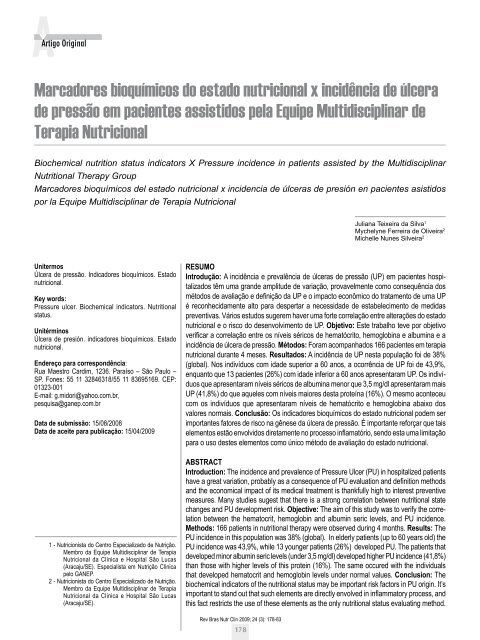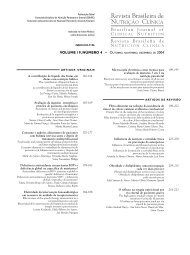Artigo - Sociedade Brasileira de Nutrição Parenteral e Enteral
Artigo - Sociedade Brasileira de Nutrição Parenteral e Enteral
Artigo - Sociedade Brasileira de Nutrição Parenteral e Enteral
You also want an ePaper? Increase the reach of your titles
YUMPU automatically turns print PDFs into web optimized ePapers that Google loves.
<strong>Artigo</strong> Original<br />
Silva JT<br />
Marcadores bioquímicos do estado nutricional x incidência <strong>de</strong> úlcera<br />
<strong>de</strong> pressão em pacientes assistidos pela Equipe Multidisciplinar <strong>de</strong><br />
Terapia Nutricional<br />
Biochemical nutrition status indicators X Pressure inci<strong>de</strong>nce in patients assisted by the Multidisciplinar<br />
Nutritional Therapy Group<br />
Marcadores bioquímicos <strong>de</strong>l estado nutricional x inci<strong>de</strong>ncia <strong>de</strong> úlceras <strong>de</strong> presión en pacientes asistidos<br />
por la Equipe Multidisciplinar <strong>de</strong> Terapia Nutricional<br />
Unitermos<br />
Úlcera <strong>de</strong> pressão. Indicadores bioquímicos. Estado<br />
nutricional.<br />
Key words:<br />
Pressure ulcer. Biochemical indicators. Nutritional<br />
status.<br />
Unitérminos<br />
Úlcera <strong>de</strong> presión. indicadores bioquímicos. Estado<br />
nutricional.<br />
En<strong>de</strong>reço para correspondência:<br />
Rua Maestro Cardim, 1236. Paraíso – São Paulo –<br />
SP. Fones: 55 11 32846318/55 11 83695169. CEP:<br />
01323-001<br />
E-mail: g.midori@yahoo.com.br,<br />
pesquisa@ganep.com.br<br />
Data <strong>de</strong> submissão: 15/08/2008<br />
Data <strong>de</strong> aceite para publicação: 15/04/2009<br />
1 - Nutricionista do Centro Especializado <strong>de</strong> <strong>Nutrição</strong>.<br />
Membro da Equipe Multidisciplinar <strong>de</strong> Terapia<br />
Nutricional da Clínica e Hospital São Lucas<br />
(Aracaju/SE). Especialista em <strong>Nutrição</strong> Clínica<br />
pelo GANEP.<br />
2 - Nutricionista do Centro Especializado <strong>de</strong> <strong>Nutrição</strong>.<br />
Membro da Equipe Multidisciplinar <strong>de</strong> Terapia<br />
Nutricional da Clínica e Hospital São Lucas<br />
(Aracaju/SE).<br />
REsUmo<br />
Introdução: A incidência e prevalência <strong>de</strong> úlceras <strong>de</strong> pressão (UP) em pacientes hospitalizados<br />
têm uma gran<strong>de</strong> amplitu<strong>de</strong> <strong>de</strong> variação, provavelmente como consequência dos<br />
<br />
é reconhecidamente alto para <strong>de</strong>spertar a necessida<strong>de</strong> <strong>de</strong> estabelecimento <strong>de</strong> medidas<br />
preventivas. Vários estudos sugerem haver uma forte correlação entre alterações do estado<br />
nutricional e o risco do <strong>de</strong>senvolvimento <strong>de</strong> UP. objetivo: Este trabalho teve por objetivo<br />
<br />
incidência <strong>de</strong> úlcera <strong>de</strong> pressão. métodos: Foram acompanhados 166 pacientes em terapia<br />
nutricional durante 4 meses. Resultados: A incidência <strong>de</strong> UP nesta população foi <strong>de</strong> 38%<br />
(global). Nos indivíduos com ida<strong>de</strong> superior a 60 anos, a ocorrência <strong>de</strong> UP foi <strong>de</strong> 43,9%,<br />
enquanto que 13 pacientes (26%) com ida<strong>de</strong> inferior a 60 anos apresentaram UP. Os indivíduos<br />
que apresentaram níveis séricos <strong>de</strong> albumina menor que 3,5 mg/dl apresentaram mais<br />
UP (41,8%) do que aqueles com níveis maiores <strong>de</strong>sta proteína (16%). O mesmo aconteceu<br />
com os indivíduos que apresentaram níveis <strong>de</strong> hematócrito e hemoglobina abaixo dos<br />
valores normais. Conclusão: Os indicadores bioquímicos do estado nutricional po<strong>de</strong>m ser<br />
importantes fatores <strong>de</strong> risco na gênese da úlcera <strong>de</strong> pressão. É importante reforçar que tais<br />
<br />
para o uso <strong>de</strong>stes elementos como único método <strong>de</strong> avaliação do estado nutricional.<br />
AbstRACt<br />
Introduction: The inci<strong>de</strong>nce and prevalence of Pressure Ulcer (PU) in hospitalized patients<br />
<br />
and the economical impact of its medical treatment is thankfully high to interest preventive<br />
measures. Many studies sugest that there is a strong correlation between nutritional state<br />
changes and PU <strong>de</strong>velopment risk. objective: The aim of this study was to verify the correlation<br />
between the hematocrit, hemoglobin and albumin seric levels, and PU inci<strong>de</strong>nce.<br />
methods: 166 patients in nutritional therapy were observed during 4 months. Results: The<br />
PU inci<strong>de</strong>nce in this population was 38% (global). In el<strong>de</strong>rly patients (up to 60 years old) the<br />
PU inci<strong>de</strong>nce was 43,9%, while 13 younger patients (26%) <strong>de</strong>veloped PU. The patients that<br />
<strong>de</strong>veloped minor albumin seric levels (un<strong>de</strong>r 3,5 mg/dl) <strong>de</strong>veloped higher PU inci<strong>de</strong>nce (41,8%)<br />
than those with higher levels of this protein (16%). The same occured with the individuals<br />
that <strong>de</strong>veloped hematocrit and hemoglobin levels un<strong>de</strong>r normal values. Conclusion: The<br />
biochemical indicators of the nutritional status may be important risk factors in PU origin. It’s<br />
<br />
this fact restricts the use of these elements as the only nutritional status evaluating method.<br />
Rev Bras Nutr Clin 2009; 24 (3): 178-83<br />
178<br />
Juliana Teixeira da Silva 1<br />
Mychelyne Ferreira <strong>de</strong> Oliveira 2<br />
Michelle Nunes Silveira 2



